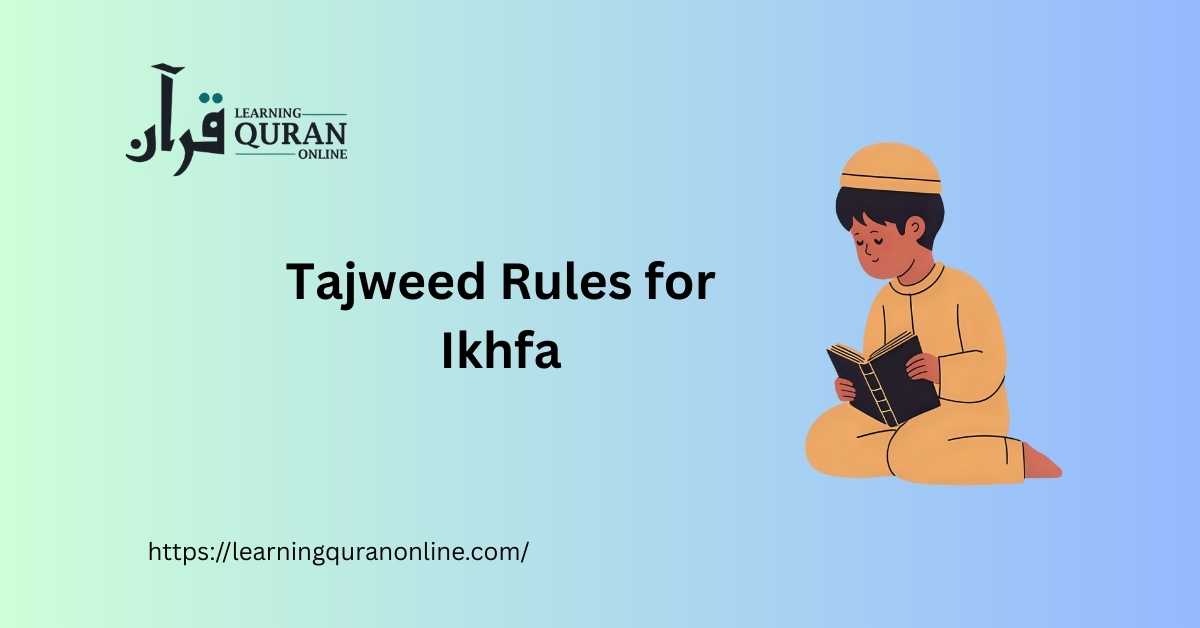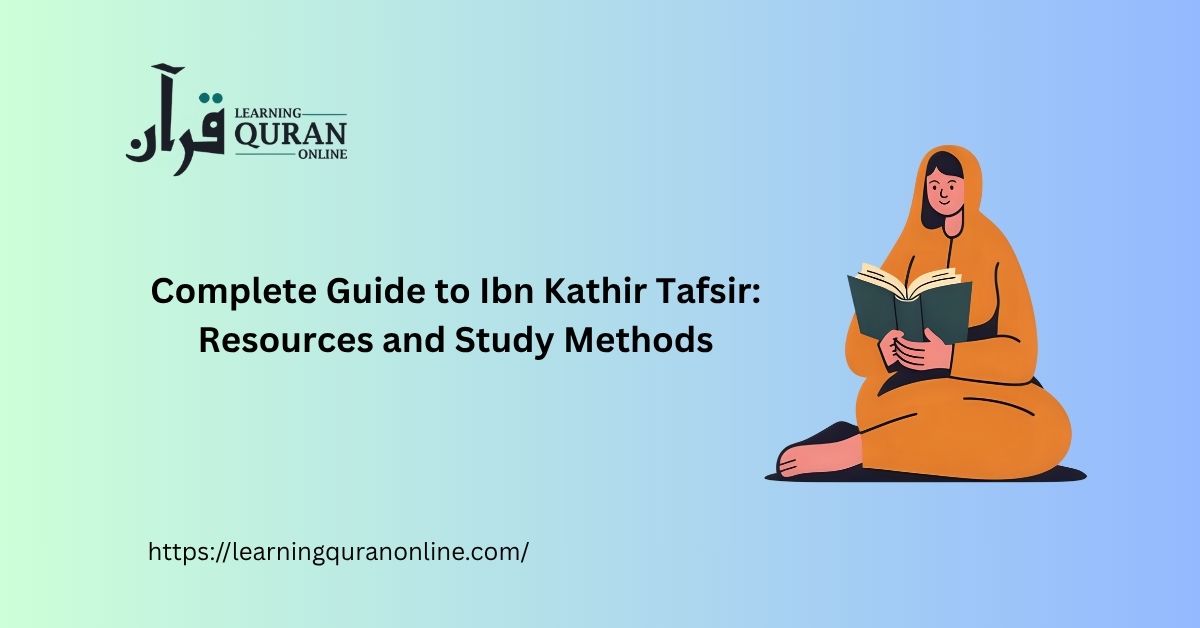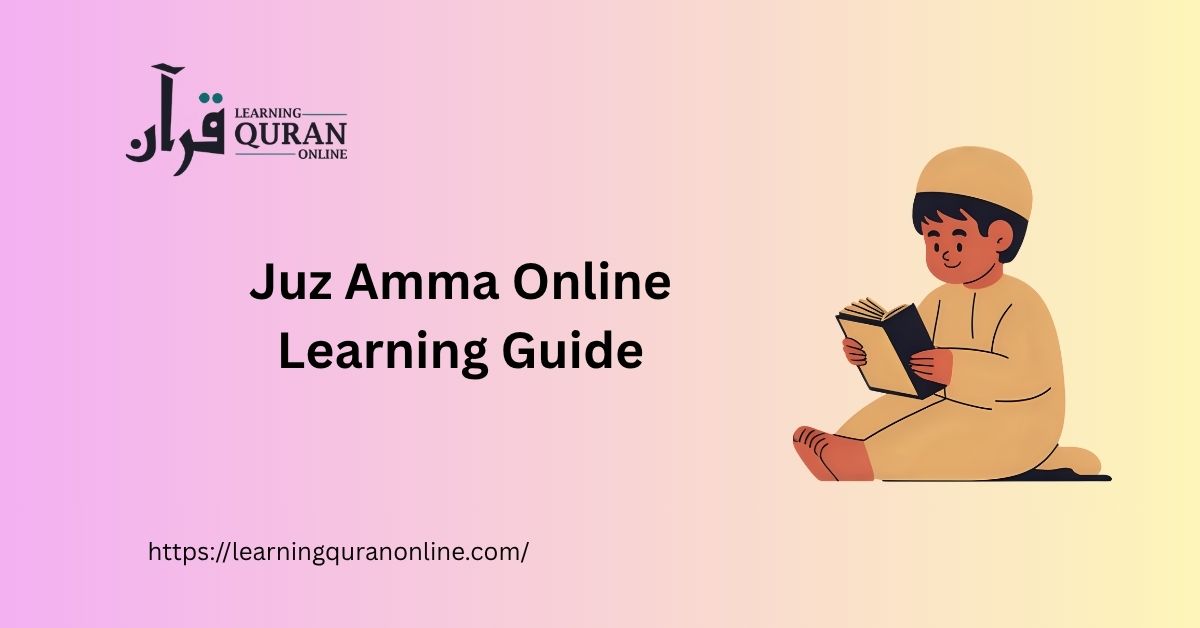Table of Contents
ToggleWhat is Ikhfa? (Definition and Purpose)
Ikhfa, linguistically meaning “to hide” or “to conceal,” in Tajweed refers to partially concealing the sound of a noon sakinah (نْ) or tanween (ً ٌ ٍ) so the sound becomes nasalized and flows into the next letter without a full pronunciation of the noon. The result is a light, nasalized sound called ghunnah (nasalization) combined with a slight concealment of the noon’s clear articulation. Ikhfa maintains clarity while allowing smooth linking between letters, improving both accuracy and melodious recitation.
Why Ikhfa Matters in Tajweed
Observing Ikhfa is critical for:
- Preserving the Qur’anic text’s correct phonetic shape and meaning.
- Adding the proper melodic rhythm and nasal quality (ghunnah) expected in classical recitation.
- Preventing mispronunciations that can change words or disrupt Tajweed rules like Idgham, Iqlab, or Izhar.
Types of Ikhfa (Including What “Ikhfa” Likely Refers To)
Generally, Ikhfa is taught in two main contexts in Tajweed instruction:
- Ikhfa (Noon Sakinah & Tanween) — Applies when a noon sakinah (نْ) or any tanween is followed by specific letters that require concealment.
- Ikhfa’ Shafawi (Meem Sakinah) — A special form of Ikhfa that applies when a meem sakinah (مْ) is followed by the letter ب (ba).
In this article we will call the general noon rule “Ikhfa” and the meem rule “Ikhfa Shafawi.” The phrase Ikhfa used in this post is treated as the subject of mastering Ikhfa rules in writing and recitation — a practical Tajweed “rite” or practice.
Ikhfa for Noon Sakinah and Tanween — The Main Rule
When a noon sakinah (نْ) or tanween appears, its behavior depends on the next letter. There are four possible Tajweed outcomes:
- Izhar (clear articulation): When followed by throat letters (ء هـ ع ح غ خ), the noon is pronounced clearly without nasal concealment.
- Idgham (merging): When followed by certain letters (ي ر م ل و ن), the noon sound merges into the following letter.
- Iqlab (conversion): When followed by the letter ب (ba), the noon converts into a meem sound with ghunnah.
- Ikhfa (concealment): When followed by 15 specific letters, the noon is partially hidden, producing a nasalized, light sound (ghunnah) that blends into the next letter.
The Ikhfa letters are: ت ث ج د ذ ز س ش ص ض ط ظ ف ق ك (15 letters). When noon sakinah or tanween precede any of these, apply Ikhfa.
How to Pronounce Ikhfa (Noon)
Follow these steps for correct Ikhfa:
- Start with awareness of the noon sakinah (or tanween) in the word.
- Check the next letter — if it is one of the 15 Ikhfa letters, apply Ikhfa.
- Produce a light nasal sound (ghunnah) for approximately two counts (some reciters use 2 beats). The noon is not fully pronounced; it is partially hidden.
- Ensure the articulation point (makhraj) shifts slightly toward the following letter without a full release of the noon’s makhraj.
Other Relevant Blogs:
- Tajweed Rules for Qalqalah
- Tajweed Rules for Ghunna
- Tajweed Rules for Meem Saakin
- Tajweed Rules for Noon Saakin and Tanween
- Tajweed Rules for Stopping and Starting
- Tajweed Rules for Madd
Ikhfa’ Shafawi (Meem Sakinah before Ba)
Ikhfa Shafawi applies when a meem sakinah (مْ) is followed by the letter ب (ba). Instead of pronouncing the meem clearly or merging it, you produce a nasalized (ghunnah) sound and conceal the exact meem articulation while preparing to pronounce the ba. This is different from:
- Idgham Shafawi: meem sakinah followed by another meem → full merge with ghunnah.
- Izhar Shafawi: meem sakinah followed by any letter other than ب or م → pronounce the meem clearly.
Pronunciation Tips for Ikhfa Shafawi
Focus on producing a light nasal glide, keeping the lips slightly prepared for the upcoming ba. The ghunnah here should be audible but not exaggerated, and the meem sound is only partially released.
Common Examples from the Quran
Practice with real Quranic words to internalize Ikhfa. Examples (transliteration provided to show the rule):
- Noon Ikhfa: “مِن شَرِّ” (min sharri) — noon sakinah before ش → Ikhfa with ghunnah.
- Noon Ikhfa: “مَن تَابَ” (man taba) — tanween/noon before ت → Ikhfa.
- Iqlab (for contrast): “مَن بَعْدِهِ” (man ba’dihi) — noon followed by ب → Iqlab (noon becomes meem with ghunnah).
- Ikhfa Shafawi: “لَمْ يَبْقَ” (lam yabqa) — meem sakinah followed by ب → Ikhfa Shafawi.
- Idgham Shafawi (contrast): “مِمَّا” (mimma) — meem sakinah + meem → Idgham Shafawi (merge with ghunnah).
Common Mistakes to Avoid
Many learners unintentionally misapply Ikhfa, producing errors that can distort the recitation. Watch for:
- Pronouncing the noon fully instead of using concealment (no ghunnah).
- Over-emphasizing ghunnah (too long nasalization).
- Confusing Ikhfa with Idgham or Iqlab — always check the following letter carefully.
- Neglecting Ikhfa Shafawi vs. Idgham Shafawi for meem rules — identify meem or noon first.
Practical Steps to Master Ikhfa (Training Plan)
Consistent practice and guided listening help you internalize Ikhfa. Follow this practical plan:
- Learn and memorize the groups of letters for Izhar, Idgham, Iqlab, and Ikhfa — flashcards help.
- Listen to proficient reciters (qurra) and follow along with text to hear Ikhfa in context.
- Practice short Quranic verses that contain Ikhfa daily, focusing on timing and ghunnah duration.
- Record your recitation and compare it to a teacher or a qari to spot differences.
- Seek corrective feedback from a qualified Tajweed teacher; small adjustments to makhraj make big improvements.
Tools and Resources for Practice
Useful resources include Tajweed books, online lessons, interactive apps, and audio recitations. Consider:
- Audio recitations by classical qurrā’ (e.g., Hafs, Warsh) to hear stylistic variations.
- Mobile apps that highlight Tajweed rules in the Mushaf as you listen.
- One-on-one Tajweed lessons to correct articulation, available through many online Quran academies.
How to Evaluate Your Progress
Track improvements by recording weekly recitations and noting:
- Accuracy of rule application (did you apply Ikhfa where required?).
- Quality of ghunnah (consistent, around 1–2 beats as recommended by your teacher).
- Clarity of articulation (makhraj alignment with the following letter).
- Ability to identify rules in new passages without marking them first.
Conclusion — Make Ikhfa a Natural Part of Your Recitation
Mastering Ikhfa greatly enhances your Quranic recitation, making it both accurate and beautiful. By understanding the types (noon and shafawi), memorizing the letter groups, practicing with examples, and getting consistent feedback, Ikhfa becomes second nature. For structured Tajweed lessons and personalized guidance to perfect Ikhfa practices, consider enrolling with qualified online instructors such as those at Learning Quran Online.
Quick Reference Summary
- Ikhfa: Partial concealment of noon sakinah/tanween when followed by 15 letters (ت ث ج د ذ ز س ش ص ض ط ظ ف ق ك) — produces ghunnah.
- Iqlab: Noon sakinah/tanween followed by ب — converts to meem + ghunnah.
- Idgham: Merge noon sakinah/tanween into certain letters (ي ر م ل و ن).
- Izhar: Clear pronunciation before throat letters (ء هـ ع ح غ خ).
- Ikhfa Shafawi: Meem sakinah followed by ب — partial concealment with ghunnah.
With regular listening, guided practice, and attention to makhraj and sifaat, the Tajweed rules for Ikhfa will transform your recitation into one that is accurate, gentle, and spiritually uplifting. May your efforts be rewarded and your recitation improve with every session.










